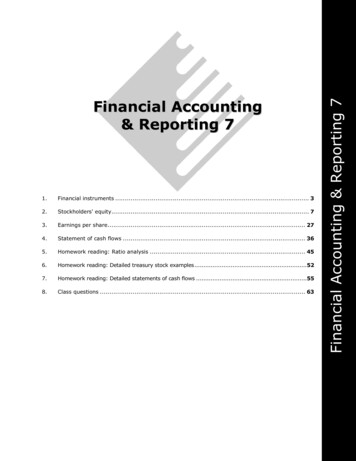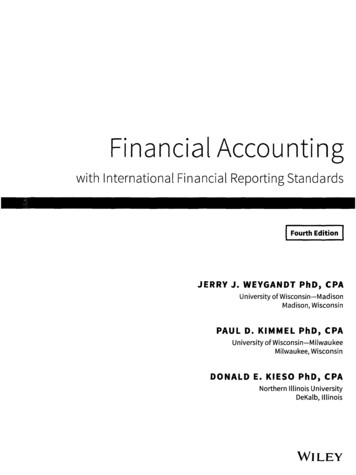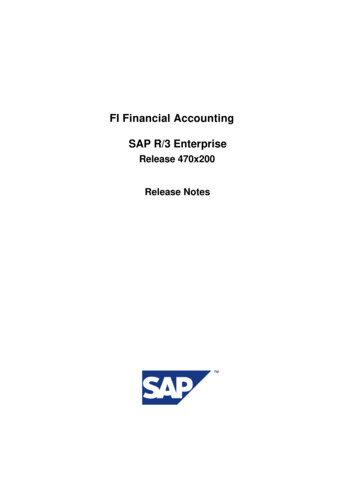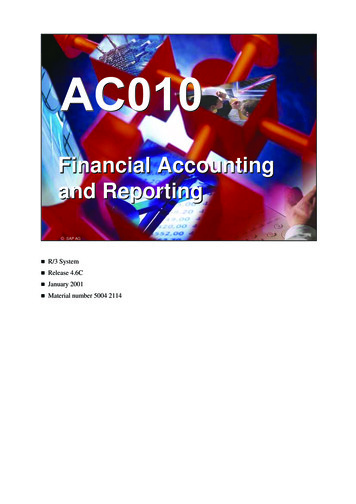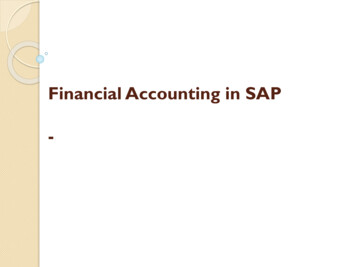
Transcription
Financial Accounting in SAP-
Introduction to SAP ERP LogisticsLogistics ComponentsEnterprise Structure in SAPTable of ContentsIntroduction SAP Financial Accounting (FI) Integration of Financial Accounting withother components
Introduction Enterprise resource planning (ERP) is business process managementsoftware that allows an organization to use a system of integratedapplications to manage the business and automate many back officefunctions related to technology, services and human resources. ERPsoftware integrates all facets of an operation, including productplanning, development, manufacturing, sales and marketing.ERP software is considered an enterprise application as it is designedto be used by larger businesses and often requires dedicated teams tocustomize and analyze the data and to handle upgrades anddeployment. In contrast, Small business ERP applications arelightweight business management software solutions, customized forthe business industry you work in.An Enterprise Resource Planning (ERP) System is a fully integratedBusiness Management System covering the functional areas of anenterprise, such as Accounting, Finance, Human Resources, Logisticsand Production etc. (Anderson, 2011).
IntroductionThe word of “Integration” is the key element for ERPimplementation. An ERP system is an attempt to integrateall functions across a company to a single computersystem that can serve all specific needs of users: It organizes and integrates operation processes andinformation flows etc. to make the optimum use ofresources such as people, material, money and machineetc. It may also integrate key customers and suppliers aspart of the enterprise’s operation. It provides integrated database and custom-designedreport systems. It adopts a set of “best practices” for carrying out allbusiness processes.
IntroductionEnterprise resource planning promises: one database, one application, and one user interface for the entireenterprise, where once disparate systemsruled manufacturing, distribution, financeand sales etc.
Introduction In today’s world, there are many leading marketproviders of ERP system and SAP is one of themarket and technology leaders in buildingbusiness software towards structured work anddata management in organizations. SAP standsfor Systems, Applications and Products in DataProcessing. SAP AG is originally Germanmultinational software who deals in softwaredevelopment for business management andimproved customer relations in enterprises.
Introduction Systems Analysis and Program Development(SAP) was founded in June, 1972 and since then,many SAP ERP operations modules hasemerged that are designed focusing on variousdifferent processes including SAP ERP sales andservice, sales and distribution, customerrelationship, financial management, businessintelligence and more. SAP developmentmodules are the following:
IntroductionSAP Financial Accounting (FI) SAP Controlling (CO) SAP Sales and Distribution (SD) SAP Production Planning (PP) SAP Materials Management (MM) SAP Quality Management (QM) SAP Human Capital Management (HCM)
Introduction These modules are highly integrated in real-time, which means that ifinformation is shared between modules then the data is entered onlyonce. This reduces the chances of error arising from repetitive entryand also reduces the man-hours. Managers and decision makers alwayshave information at their fingertips and this helps then in effectivedecision making. SAP has been around for over three decades.SAP is the leading ERP (Enterprise Resource Planning) software.Because of it’s liberal open-architecture, there are millions ofprogrammers working around the world to provide interactionbetween thousands of major software and SAP. SAP is usuallyimplemented in phases. The first phase is when organizationalstructure and accounting components are configured, tested and thentaken live. Gradually more modules are turned on (SAP, 2014a).
SAP Financial Accounting (FI) SAP Financial Accounting (FI) is an importantcore module where in live-time, the financialprocessing transactions are all captured toprovide the basis via which data is drawn forexternal reporting. This SAP FI Module isintegrated with many parallel modules thatenable a company to unify processes that mayhave needed the utilization of many softwarepackages (Brinkmann - Zeilinger, 2000). .
SAP Financial Accounting (FI) SAP FI module deals in managing financial transactionswithin enterprises. This financial accounting module helpsemployees to manage data involved in any financial andbusiness transactions in a unified system. This modulefunctions very well for reporting requirements. The SAPFI module is very flexible and is functions well in any typeof economic situation. Be it a smaller organization or alarger organization, SAP implementation helps inconsolidating data for diverse business transactions andlegal requirements. Financial Accounting module helpsone to get real-time financial position of an enterprise inthe market. SAP FI incorporates with other SAP modulessuch as SAP SD, SAP MM, SAP PP, Payroll and more forbetter work results.
SAP Controlling (CO) SAP CO module is another important SAPmodules offered to enterprises. The controllingmodule supports in the process works ofplanning, reporting and monitoring operationsof businesses. It involves methods to view andorganize costs that are required for financialreporting. Controlling module enables one toplan, track, perform and report about costs.Controlling includes managing and configuringmaster data that covers cost elements, costcenters, profit centers, internal orders, andfunctional area and so on.
SAP NetWeaver BusinessWarehouse (BW) SAP is the most important and greatest solution inenterprise resource planning (ERP), and one of itsbusiness intelligence (BI) solutions is SAP NetWeaverBusiness Warehouse (BW).The Business Explorer Suite is a component of SAPNetWeaver Business Warehouse. The Figure 1. overviewsthe BEx tolls’ integration into the SAP NetWeaver BWarchitecture. The SAP BusinessObjects BusinessIntelligence Platform provides a series of otherapplications for an enterprise-wide, end-to-end reportingscenario that go far beyond the functional scope of theBusiness Explorer tools. (Dinkel et al., 2011)
SAP NetWeaver BusinessWarehouse (BW)The Business Explorer contains the undermentioned reporting tools: BEx Query Designer, BEx Analyzer, BEx Web Analyzer, BEx Web Application Designer, BEx Report Designer Information Broadcasting.
SAP NetWeaver BusinessWarehouse (BW) The BW query is the central reporting interfacefor analyzing Business Intelligence data within theSAP NetWeaver BW architecture. However, anSAP query can be used as a data source duringextraction from SAP source systems to the BWsystem. When the term query is used within theconnection of data analysis in a BW system, theBW query is meant. (Heilig et al., 2012)
SAP Sales and Distribution(SD) SAP SD modules deal in managing alltransactions ranging from enquiries, proposals,quotations and pricing and more. The sales anddistribution module helps greatly in inventorycontrol and management. SAP SD moduleconsists of master data, system configurationand transactions. Some of the sub-componentsof SAP SD module are: master data, salessupport, sales, shipping and transportation,billing, credit management, and so on.
SAP Production Planning (PP) SAP PP module is another important modulethat includes software designed specifically forproduction planning and management. Thismodule also consists of master data, systemconfiguration and transactions in order toaccomplish plan procedure for production. SAPPP module collaborate with master data, salesand operations planning, distribution resourceplanning, material requirements planning,Kanban, product cost planning and so on whileworking towards production management inenterprises (Hilgefort, 2012).
SAP Materials Management(MM) SAP MM module as the term suggestsmanages materials required, processedand produced in enterprises. Differenttypes of procurement processes aremanaged with this system. Some of thepopular sub-components in SAP MMmodule are vendor master data,consumption based planning, purchasing,inventory management, invoiceverification and so on.
SAP Quality Management(QM) SAP QM module helps in management ofquality in productions across processes inan organization. This quality managementmodule helps an organization toaccelerate their business by adopting astructured and functional way of managingquality in different processes. SAP QMmodule collaborates in procurement andsales, production, planning, inspection,notification, control, audit managementand so on.
SAP Human CapitalManagement (HCM) SAP HCM module enhances the work processand data management within HR department ofenterprises. Right from hiring a person toevaluating one’s performance, managingpromotions, compensations, handling payrolland other related activities of an HR isprocessed using this module. The task ofmanaging the details and task flow of the mostimportant resource i.e. human resource ismanaged using this SAP ERP HCM module
SAP Financial Accounting (FI) SAP FI ( Financial Accounting ) is one the functional module in SAPsoftware. SAP FI module as the term suggests deals in managingfinancial transactions within enterprises. This financial accountingmodule helps employees to manage data involved in any financialand business transactions in a unified system. This module functionsvery well for reporting requirements.The SAP FI module is very flexible and is functions well in any typeof economic situation. Be it a smaller organization or a largerorganization, SAP implementation helps in consolidating data fordiverse business transactions and legal requirements. FinancialAccounting module helps one to get real-time financial position ofan enterprise in the market. SAP FI incorporates with other SAPmodules such as SAP SD, SAP MM, SAP PP, Payroll and more forbetter work results (Dinkel et al, 2011).
SAP Financial Accounting (FI) Company-wide control and integration offinancial information is essential tostrategic decision making, SAP ERPFinancials enables you to centrally trackfinancial accounting data within aninternational framework of multiplecompanies, languages, currencies, andcharts of accounts (Hernandez et al,2006) .
SAP Financial Accounting (FI)SAP FI module mainly deals with Fixed asset accrual bank cash journal inventory tax accounting General ledger, Accounts receivable accounts payable AR/AP, Fast close functions Financial statements Parallel valuations
SAP Financial Accounting (FI)2.1 Integration of Financial Accounting with othercomponentsAll accounting-relevant transactions made in Logistics(LO) or Human Resources (HR) components are postedreal-time to Financial Accounting by means of automaticaccount determination. This data can also be passed on toControlling (CO). This ensures that logistical goodsmovements (such as goods receipts and goods issues) areexactly reflected in the value-based updates in accounting.Integration within Financial Accounting.Every posting that is made in the subledgers generates acorresponding posting to the assigned G/L accounts. Thisensures that the subledgers are always reconciled with thegeneral ledger (I05).
SAP Financial Accounting (FI)The Financial Accounting application componentcomprises the following sub-components:General Ledger (FI-GL) The central task of G/L accounting is to provide acomprehensive picture for external accounting bymeans of accounts. Recording all value-related businesstransactions (primary postings as well as settlementsfrom internal accounting) in a software system that isfully integrated with all the other operational areas of acompany ensures that the accounting data is alwayscomplete and accurate.
SAP Financial Accounting (FI)General Ledger (FI-GL) Essentially, the general ledger serves as acomplete record of all business transactions. Itis the centralized, up-to-date reference for therendering of accounts. Actual individualtransactions can be checked at any time in realtime processing by displaying the originaldocuments, line items, and transaction figures atvarious levels such as: account information,journals, totals/transaction figures, balancesheet/profit and loss evaluations (I05).
SAP Financial Accounting (FI)Accounts Payable (FI-AP) The Accounts Payable application componentrecords and administers accounting data for allvendors. It is also an integral part of thepurchasing system, where deliveries and invoicesare managed according to vendors. The systemautomatically makes postings in response to theoperative transactions. In the same way, thesystem supplies the Cash Managementapplication component with figures frominvoices in order to optimize liquidity planning.
SAP Financial Accounting (FI)Accounts Receivable (FI-AR) The Accounts Receivable applicationcomponent records and administersaccounting data ofall customers. It is alsoan integral part of sales management.
SAP Financial Accounting (FI)Bank Accounting (FI-BL) This component is used to handleaccounting transactions that you processwith your bank. It includes themanagement of bank master data, cashbalance management (check and bill ofexchange management), and the creationand processing of incoming and outgoingpayments.
SAP Financial Accounting (FI)Asset Accounting (FI-AA) Asset Acoounting is a sub component of SAP FI Module. It dealswith the fixed assets of the compant for their management andanalysis/ It provides the complete information about the fixedassets transactions inside a company. So, the Asset Accounting (FIAA) component is used for managing and supervising fixed assetswith the SAP System. In Financial Accounting, it serves as a subsidiary ledger to theGeneral Ledger, providing detailed information on transactionsinvolving fixed assets. SAP Asset Accounting is tightly integratedwith many other moduels like MM, PM etc. For example if an itempurchased that can be considered as an asset, the information willpass to Asset Accounting module ( FI-AA) from MM module.
SAP Financial Accounting (FI)Funds Management (FI-FM) SAP Funds management ( FI-FM ) is another subcomponent under FI module. As the name it helps theorganization to manage funds. It helps the companies forproper budgeting and avoiding overrun budgets. Fundsmanagement integrate with many modules like GeneralLedger Accounting ( G/L ), bank accounting , Materialmanagement ( MM ) etc to get the complete funds data.It checks all the transactions like where from receivingthe funds, and where is all the funds expenditure occursand which are the funds to receive in future. based onthese data, organization can plan and create theirforecasting budgets and can utilize their funds morebetter way.
SAP Financial Accounting (FI)Travel Management (FI-TV) SAP Travel Management supports allprocesses involved in handling businesstrips. Its comprehensive functionality isintegrated with settlement, taxation, andpayment processes. Travel Managementenables you to request, plan, and booktrips, create travel expense reports, andtransfer expense data to other functionalareas.
SAP Financial Accounting (FI)Special Purpose Ledger (FI-SL) Special purpose ledgers are ledgersdefined to meet the specific businessrequirements, according to thedimensions you define. They contains thedimensions that you specify. This is theonly type of ledger you can create in yourFI-SL system (SAP, 2014c).
2.2 SAP FI General LedgerAccountingSAP General Ledger Accounting ( Shortly G/LAccounting ) is one of the main sub component of SAPFI module. A general ledger is the data that containsentire transactions of a company. It acts as the mainrecord for all accounting purposes. The central task of G/L accounting is to provide acomprehensive picture for external accounting andaccounts. Recording all business transactions (primarypostings as well as settlements from internalaccounting) in a software system that is fully integratedwith all the other operational areas of a companyensures that the accounting data is always complete andaccurate.
2.2 SAP FI General LedgerAccounting Essentially, the general ledger serves as a completerecord of all business transactions. It is the centralized,up-to-date reference for the rendering of accounts.Actual individual transactions can be checked at anytime in realtime processing by displaying the originaldocuments, line items, and transaction figures atvariouslevels such as: Account informationJournalsTotals/transaction figuresBalance sheet/profit and loss evaluations(SAP General Ledger Accounting, FI-GL, 2001)
2.2 SAP FI General LedgerAccountingIt contains all the transactions like purchases fromvendors and customer transactions and other insidecompany transactions. Important Transaction codes for SAP FI GeneralLedger FB50 - Enter GL Account DocumentF-01 - Enter Sample DocumentFB02 – Change DocumentF-06 - Post Incoming PaymentsF-07 - Post Outgoing PaymentsFBCJ - Cash journal Posting
2.2.1. FI OrganizationalStructureOrganizational structures occur in all importantfunctional areas of the SAP system. Represents the legal and/or organizational views of anenterprise. Forms a framework that supports the activities of abusiness in the manner desired by management. Permits the accurate and organized collection ofbusiness information. Supports the development and presentation of relevantinformation in order to enable and support businessdecisions.
2.2.1. FI OrganizationalStructureElements in FI Organizational Structure Client: An independent environment in thesystem. Client is an obligatory organizationalunit (field name: Mandant), a commercially,organizationally, and technically self-containedunit within the SAP system, with its own masterrecords and tables.
2.2.1. FI OrganizationalStructureElements in FI Organizational Structure Client: We can have more than one client defined in theSAP system. The standard SAP system comes deliveredwith clients 000 and 001. Because the client is thehighest level in the SAP system, and FI module hierarchy,any specification we make or data we enter at this levelis valid for all company codes and for all otherorganizational structures within that client. This ensures that the data is consistent: we need tomake specifications or enter data only once. We need toenter a client key (three-digit identifier) when we log onto the SAP system.
2.2.1. FI OrganizationalStructureElements in FI Organizational Structure Client: The data entry, processing, and analysis are allsaved for each client. Used for external reportingpurposes, the organizational units of FI are designed tofulfill our business requirements and meet the legal orstatutory regulations of external parties. We assignthese organizational units to each other in order tobuild the framework for processing businesstransactions by transferring data automatically betweenthe individual components. (Narayanan, 2015.)
2.2.1. FI OrganizationalStructureElements in FI Organizational Structure Client: Before we start defining the requiredorganizational units, we need to meet the countryspecific requirements by completing the localization ofsample organizational units supplied by SAP.Specifications that we make at this level apply to allcompany codes. (Narayanan, 2015.)
2.2.1. FI OrganizationalStructureCompany Code:The most important organizational element inFinancial Accounting is the company code. It is thesmallest organizational unit of FinancialAccounting for which a complete self-containedset of accounts can be drawn up for purposes ofexternal reporting. Company Code: Represents an independent legal accounting unit Balanced set of books, as required by law, areprepared at
SAP Financial Accounting (FI) SAP Financial Accounting (FI) is an important core module where in live-time, the financial processing transactions are all captured to provide the basis via which data is drawn for external reporting. This SAP FI Module is integrated with many parallel





